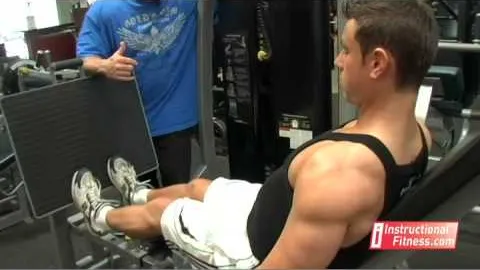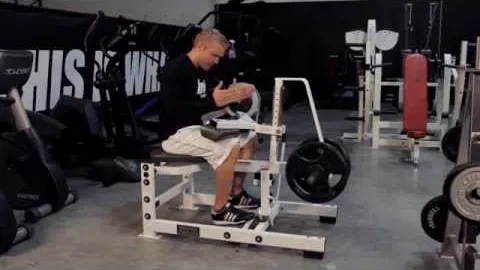


Are you looking to strengthen your calves for improved athletic performance or simply to achieve more defined lower leg muscles? The seated calf raise exercise is an effective way to target and isolate the calf muscles, leading to increased strength and size. In this article, we will provide a comprehensive guide to performing the seated calf raise exercise correctly, as well as its benefits and variations.
A seated calf raise is an isolation exercise that specifically targets the calf muscles, primarily the gastrocnemius and soleus. This exercise involves sitting on a calf raise machine or a bench with a weight plate on top of your thighs, while your feet are positioned on a platform or barbell placed at the edge. By pushing your toes downwards and lifting the weight, you contract and engage your calf muscles.
Stronger Calf Muscles: Performing seated calf raises regularly can help strengthen and develop your calf muscles, which are crucial for activities such as running, jumping, and walking.
Improved Athletic Performance: Strong calf muscles contribute to improved performance in various sports, including basketball, soccer, and sprinting. The seated calf raise is an effective way to build the strength necessary for explosive movements.
Injury Prevention: Strengthening the calves can provide stability and support to the ankles, reducing the risk of ankle sprains and other lower leg injuries.
Aesthetic Enhancement: Seated calf raises can help sculpt and tone the calves, providing a more defined and proportionate lower leg appearance.
Set up the machine: Adjust the calf raise machine or positioning bench to accommodate your height and comfort. Ensure that the ball of your foot is positioned securely on the platform or edge of the barbell.
Adjust the weight: Place a suitable weight plate on your thighs, resting just above your knees. Start with a manageable weight and gradually increase as you become more comfortable and stronger.
Position your feet: Place your toes on the platform or barbell, with your heels hanging off the edge. Your feet should be shoulder-width apart, or slightly closer if that is more comfortable for you.
Engage your core: Sit up straight and engage your core muscles for stability throughout the exercise. This will help you maintain proper form and prevent strain on your lower back.
Perform the movement: Start by pushing your toes downwards, contracting your calf muscles. Lift the weight by extending your ankles, aiming to reach a full contraction at the top of the movement. Hold for a brief moment, then slowly lower the weight back to the starting position. Repeat for the desired number of repetitions.
Breathing: Inhale as you lower the weight and exhale as you lift it during the concentric phase.
Range of motion: While performing the seated calf raise, ensure that you move through a full range of motion, reaching a full stretch at the bottom and a complete contraction at the top.
Machine Seated Calf Raise: This is the standard variation using a calf raise machine found in most gyms. Follow the steps mentioned above for proper execution.
Dumbbell Seated Calf Raise: If a calf raise machine is not available, you can use dumbbells for resistance. Sit on a bench and place the dumbbells on top of your thighs. Proceed to perform the calf raises using the same technique as described earlier.
Barbell Seated Calf Raise: Instead of using a machine or dumbbells, you can place the barbell across your thighs for added resistance. Keep the barbell steady with your hands as you perform the calf raise.
Single-Leg Seated Calf Raise: This variation involves performing the exercise one leg at a time. Sit on the calf raise machine with one leg extended, while the other foot is positioned on the platform. This variation provides a greater challenge and helps address any muscular imbalances between the legs.
Incorporating the seated calf raise into your leg workout routine can help you achieve stronger, more defined calf muscles. Whether you are an athlete aiming to enhance your performance or simply looking for aesthetic improvements, this exercise can provide significant benefits. Remember to focus on proper form, engage your core, and gradually increase the weight as you become more comfortable and stronger. Incorporate variations to keep your workouts engaging and maximize your calf muscle development. Start incorporating seated calf raises into your routine and elevate your lower leg strength to new heights!
If you're looking for a gym, fitness club or yoga studio, you've come to the right place.
You can find information about gyms in your area. Browse catalog of gyms and find gyms with classes which are you looking for.
On gym page you can find simple information like address, phone or website. You can find list of available classes. You can check availability of personal training or small group classes. On place page you can also see information about open hours.
You can find gyms near you with amenities, courts, studios and equipments.
Use our map to find gym at your city or district.
In Gym Navigator you can find list of exercises with movies for many body parts.
You can browse exercises catalog and find exercises the best of you.
You can also find exercises grouped into workout plans, which you can use to improve you body. Each routine show you exercises one by one and give you possibility to count you progress and count down rest time.